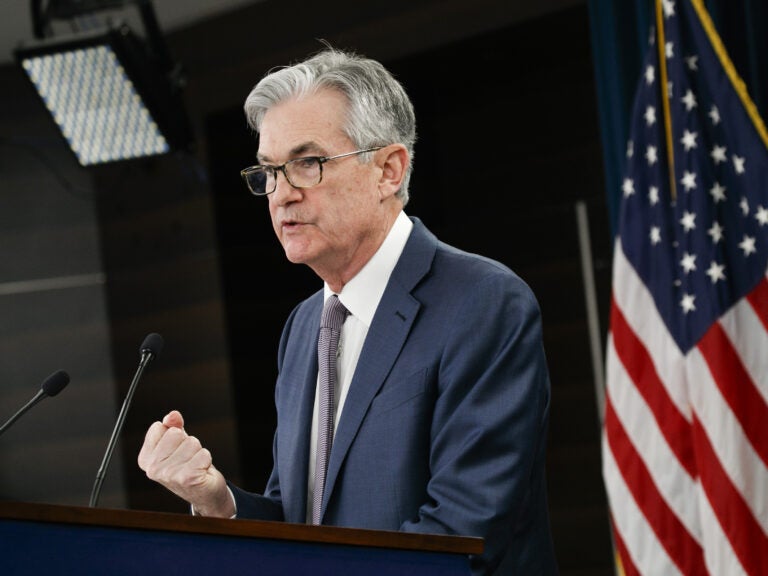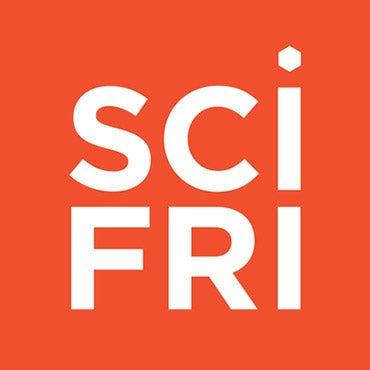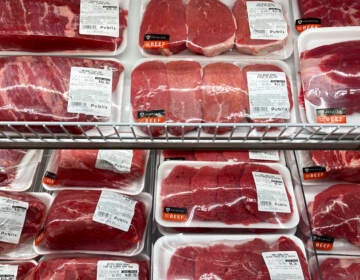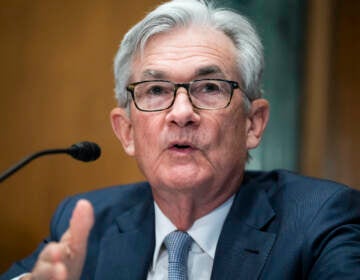Powell says Fed will hike further and faster if necessary
Powell's message was more hawkish than his comments were after last week's Fed meeting.

Federal Reserve Chair Jerome Powell speaks during a news conference in Washington in 2020. (Jacquelyn Martin/AP)
Chair Jerome Powell said Monday that the Federal Reserve would raise its benchmark short-term interest rate faster than expected, and high enough to restrain growth and hiring, if it decides this would be necessary to slow rampaging inflation.
Powell’s message was more hawkish than his comments were after last week’s Fed meeting, when officials raised their key rate a quarter-point from near zero to a range of 0.25% to 0.5%. (“Hawks” typically support higher rates to stave off inflation, while “doves” generally prefer lower rates to bolster hiring).
His remarks, in a speech to the National Association for Business Economics, caused a sharp drop in the stock market, with its implication that potentially much higher rates could be on the way for mortgages, auto loans, credit cards and other consumer and business borrowing. U.S. stocks later recovered, with the S&P 500 index ending the day down less that 0.1%.
Powell said that if necessary, the central bank would be open to raising rates by a comparatively aggressive half-point at multiple Fed meetings. The Fed hasn’t raised its benchmark rate by a half-point since May 2000.
He added, too, that the policymakers could go so far as to send rates into “restrictive” territory that would slow economic growth and possibly raise the unemployment rate, if needed to tame high inflation.
“We will take the necessary steps to ensure a return to price stability,” the Fed chair said in his speech to the NABE’s annual economic policy conference. “In particular, if we conclude that it is appropriate to move more aggressively by raising the federal funds rate by more than (a quarter-point) at a meeting or meetings, we will do so.”
The Fed is under pressure from widespread criticism that it has reacted too slowly to a price spike that has catapulted inflation to four-decade highs. When they met last week, Fed officials forecast that they would raise rates six more times this year and four times in 2023. They also projected that inflation would slow to 2.7% by the end of next year.
Powell cautioned Monday that those projections of future interest rates and inflation “can become outdated quickly at times like these, when events are developing rapidly.”
According to an NABE survey of its member economists, 77% think the Fed’s interest rate policy remains too low. Nearly the same proportion said they believed inflation would remain above 3% next year, suggesting that the Fed’s inflation expectations are too optimistic. NABE members mostly work for large businesses, consulting firms, and trade associations.
Last week, the Fed’s policymakers projected that the economy would remain resilient enough to keep growing and that the unemployment rate would fall from its current level of 3.8% to 3.5% by year’s end, matching a 50-year low reached before the pandemic.
Some economists argue that such a painless outcome — what they refer to as a “soft landing” — is unrealistic, given the challenges the economy faces, including the potential for deeper economic disruptions resulting from Russia’s invasion of Ukraine. The war has already raised the cost of oil, wheat, nickel and other vital commodities.
But Powell asserted that the Fed has achieved such soft landings before.
“I believe that the historical record provides some grounds for optimism,” he said “Soft, or at least soft-ish, landings have been relatively common in U.S. monetary history.”
Still, the Fed chair added that “no one expects that bringing about a soft landing will be straightforward in the current context — very little is straightforward in the current context.”
He acknowledged that higher oil and commodity prices serve as a reminder of the oil price spikes of the 1970s, which fed soaring inflation in that decade. It wasn’t until the early 1980s, after Chairman Paul Volcker had sent the Fed’s rate to nearly 20%, that inflation was tamed.
“Not a happy” experience, Powell acknowledged.
But he argued that the U.S. economy was less sensitive to oil prices now, in part because it is more fuel-efficient.
Powell pointed to a near-record-high level of open jobs, which topped 11 million in January. That is equivalent to 1.7 available positions for every unemployed person.
He suggested that higher rates from the Fed could slow consumer spending enough to reduce that outsize demand for workers, which would, in turn, reduce wage growth to a level that wouldn’t boost inflation.
“This is a labor market that is out of balance,” Powell said, which he acknowledged was good for workers, because it has meant higher pay for many. But those wage gains can also lead companies to raise prices to offset their higher labor costs.
“We need the labor market to be sustainably tight,” he said.
Powell’s remarks followed a flurry of comments from officials concerning Fed policy since last week’s meeting, all pointing in a hawkish direction.
Also on Monday, Raphael Bostic, president of the Federal Reserve Bank of Atlanta, said that controlling inflation “is the top concern that I have for 2022.”
Bostic also said he expects the Fed to raise rates a total of six times this year, and twice more in 2023. That is a more dovish approach than most of his colleagues. But he emphasized that this was mostly because of the extreme uncertainty currently surrounding the economy. If more rate hikes were necessary to slow inflation, he would support them, he said.
On Friday, Christopher Waller, a member of the Fed’s influential board, sounded a hawkish note in an interview on CNBC. He said he could support half-point rate hikes at each of the next two meetings of Fed policymakers.
Waller argued that while the economic data was “basically screaming at us” to raise rates by a half-point at last week’s meeting, the economic uncertainty created by Russia’s invasion of Ukraine led him to support a smaller increase out of caution.
Neel Kashkari, president of the Federal Reserve Bank of Minneapolis, who is among the most dovish policymakers, wrote that he fears that consumers, buoyed by hiring and wage gains, may keep spending at an accelerated pace even as businesses struggle to meet that demand. This pattern, he suggested, would keep inflation high.
If the trend continues, the Fed “will need to act more aggressively” and raise rates high enough to slow growth, Kashkari said.
WHYY is your source for fact-based, in-depth journalism and information. As a nonprofit organization, we rely on financial support from readers like you. Please give today.





